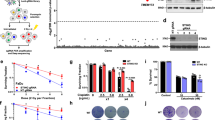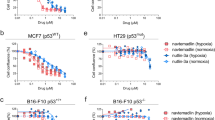Abstract
The hypoxic cell radiosensitizer RSU 1069 (1-(2-nitro-1-imidazolyl)-3-(1-aziridinyl)-2-propanol) shows, on a concentration basis, a 100-fold greater toxicity towards hypoxic relative to aerobic cells. This toxicity is substantially greater than that of misonidazole, a compound of similar electron affinity. Reductive processes are important for hypoxic toxicity; this is demonstrated by the fact that misonidazole, in excess, can protect against the hypoxic but not aerobic toxicity of RSU 1069. The importance of the interaction of RSU 1069 with DNA, suggested initially by molecular studies, is supported by the fact that cells containing 5-bromodeoxyuridine (5-BUdR) incorporated into their DNA show greater sensitivity towards the lethal effects of RSU 1069 both in air and nitrogen, compared to cells not treated with 5-BUdR. Experiments with RSU 1069 and 3-aminobenzamide (3-AB) show the latter compound to potentiate aerobic toxicity, consistent with monofunctional alkylation by RSU 1069. In contrast, 3-AB has no effect on the hypoxic cytotoxicity of RSU 1069, which would be predicted if RSU 1069 is functioning as a bifunctional agent under these conditions. It is our contention that in air, RSU 1069 functions as a typical monofunctional alkylating agent, presumably due to the presence of the aziridine group whereas, in hypoxia, reduction of the nitro group provides an additional alkylating species, converting the compound into a bifunctional agent.
This is a preview of subscription content, access via your institution
Access options
Subscribe to this journal
Receive 24 print issues and online access
$259.00 per year
only $10.79 per issue
Buy this article
- Purchase on Springer Link
- Instant access to full article PDF
Prices may be subject to local taxes which are calculated during checkout
Similar content being viewed by others
Rights and permissions
About this article
Cite this article
Stratford, I., Walling, J. & Silver, A. The differential cytotoxicity of RSU 1069: Cell survival studies indicating interaction with DNA as a possible mode of action. Br J Cancer 53, 339–344 (1986). https://doi.org/10.1038/bjc.1986.57
Issue Date:
DOI: https://doi.org/10.1038/bjc.1986.57
This article is cited by
-
The hypoxia-selective cytotoxin NLCQ-1 (NSC 709257) controls metastatic disease when used as an adjuvant to radiotherapy
British Journal of Cancer (2010)



